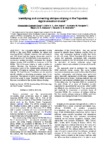Please use this identifier to cite or link to this item:
http://www.alice.cnptia.embrapa.br/alice/handle/doc/974950| Title: | Identifying and correcting oblique striping in the topodata digital elevation model. |
| Authors: | SAMUEL-ROSA, A.  ANJOS, L. H. C. dos   VASQUES, G. de M.   ANTUNES, M. A. H.   DALMOLIN, R. S. D.   |
| Affiliation: | Alessandro Samuel-Rosa, UFRRJ; Lúcia H. C. dos Anjos, UFRRJ; GUSTAVO DE MATTOS VASQUES, CNPS; Mauro A. H. Antunes, UFRRJ; Ricardo S. D. Dalmolin, UNIVERSIDADE FEDERAL DE SANTA MARIA. |
| Date Issued: | 2013 |
| Citation: | In: CONGRESSO BRASILEIRO DE CIÊNCIA DO SOLO, 34., 2013, Florianópolis. Anais... Florianópolis: Sociedade Brasileira de Ciência do Solo, 2013. |
| Description: | The Topodata digital elevation model (DEM) is the best DEM available for digital soil mapping (DSM) in Brazil. However, it is not ready to use. We show that the kriging interpolator used to downscale the SRTM DEM from 3 arc-seconds to 1 arc-second spatial resolution increased the double oblique striping (15º and 60º) so common to SRTM DEMs. This is because kriging is quite sensitive to outliers. Besides, the Gaussian model of spatial covariance used in the downscaling enhanced the sensitivity of kriging to outliers, thus enhancing the striping. 2D Fast Fourier Transform can be used to identify whether a destriping procedure need to be employed. The bilinear or cubic resampling methods should be used to warp Topodata DEMs because they are insensitive to the double oblique striping. |
| Keywords: | SRTM downscaling DEM warping 2D Fast Fourier Transform |
| Type of Material: | Artigo em anais e proceedings |
| Access: | openAccess |
| Appears in Collections: | Artigo em anais de congresso (CNPS)  |
Files in This Item:
| File | Description | Size | Format | |
|---|---|---|---|---|
| identifying.pdf | 788,44 kB | Adobe PDF |  View/Open |









